Chapter 3: Harmonization
Tonality
Tonality is the most widely studied musical language in the Western world, and had been predominantly used by composers from Bach to Wagner, and well after.
This system of pitch and chord arrangements is based on hierarchy and perceived relations between them. In tonality, we’re interested in the functions of each note of the scale, where the tonic triad is the most stable. There are 2 tonal scales: Major and minor.
Just like English, tonality is a language. Scales correspond to letters of the alphabet and simply using letters in any given order isn’t sufficient to call it “English”. Tonality works the same way.
- The concept of keys and tonality have dominated the music since at least 2 centuries.
- Tonality is hierarchical system in which each note of the scale has a function, and where there is one “main” note around which the system is organized: the tonic
- Tonality is not just about the notes themselves, but it’s about their function.
- There are 2 tonal scales: Major and minor
Primary & Secondary Functions
- Functions are indicated by a roman number under the staff (under the bass voice)
- Certain chords have a stronger function as they provide more stability, and tend to reinforce the key.
| Primary | Secondary |
|---|---|
| I | II |
| IV | III |
| V | VI |
| VII |
“Primary” functions tend to reinforce the key while “Secondary” functions tend to “dilute” tonality.
The VIIth degree most of the time will get interpreted (on paper and by our ears) as part of the dominant function (V). VII will be analysed as-is only in specific circumstances (which we might learn about in harmonic marches, for instance), in which case it will be considered as a secondary function.
The IInd function has a special status, because it is often used to approach the dominant chord, but because it has a lesser “tonal strength”, therefore it is still considered a Secondary function.
The V-I Pairing
The basis of the tonal system lies on “Dominant - Tonic” pairing (V-I). There are 2 typical movements that are the most typical of this pairing:
- Lead-tone resolving upward
- Ascending fourth, or descending fifth
- Vth degree is the primary driving force of the tonal system, especially when extended (dominant 7th, altered 5th, 9th)
- The presence of the tonic function is not even necessary: V is sufficient, because the IV-V and II-V parings cannot be interpreted in any other key.
The Queen of the game is V, while I is the king, and is a lot more passive.
The Cycle of Fifths
- Like we’ve seen, the V-I couple is the base of the tonal system.
- This V-I relationship can be extrapolated to other chord relationships.
- i.e. I-IV, and so on.
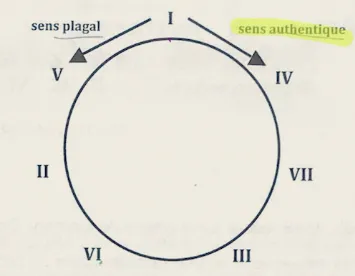
The cycle of fifths can move in 2 directions:
- Authentic: V-I
- Plagal: I-V
There are 3 stages to a harmonic progression:
- Approach the dominant
- Dominant
- Resolution
Principles for building a harmonic scheme that’s tonal and coherent:
- I can move to any degree
- All degrees can move to V
- You can always move in the authentic direction (clock-wise)
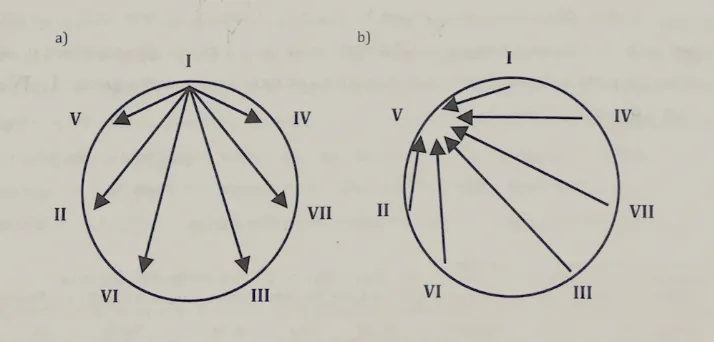
Substitutions
Some chords in tonal music can be substituted because they share similar “tonal functions”, here are some of them:
- I can be replaced by III, VI, or IV6
- II can be replaced by IV

Hierarchy of Progressions
This is a summary of the system that Schönberg came up with, that is based on intervals.
| Strong | Weak |
|---|---|
| Asc. 4rth | Asc. 3rd |
| Desc 3rd | Asc. 5 |
| Asc & Desc 2 (from or to V) |
Weak Progressions
You CAN use them, but you might want to keep this in mind:
- Don’t chain them (I-III-V)
- Step-wise voice-leading
- If you can avoid using those on strong beats.
Cadenzas
Functions of Cadenzas
- Cadenzas are stereotypical musical formulas used as punctuation for musical phrasing.
- Especially having V-I at the end of a phrase.
- At the cadenzas, we often observe changes to the musical texture:
- Harmonic rhythms (either speeding up or slowing)
- “The Rule of least effort” sometimes can be pushed aside.
- More dense chords (such as 7ths, etc)
When writing homework, you’ll want to identify them.
Types of Cadenzas
- Conclusive: Those that sound final
- Suspensive: Those that don’t
(Perfect) Authentic Cadenza (PC or PAC)
- Authentic Cadenza (V-I)
- Perfect Authentic Cadenza (V-I but with lead-tone resolution on the soprano)
- Conclusive
- V-I
- Both chords need to be in root position
- Needs to be cadential resting point
- lead-tone to tonic resolution at the soprano
- It’s not absolutely essential, but it sounds more final.
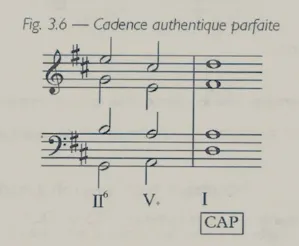
- It’s not absolutely essential, but it sounds more final.
Imperfect Authentic (IC)
- One of the chords in V-I is inverted:
- V6-I
- V-I6
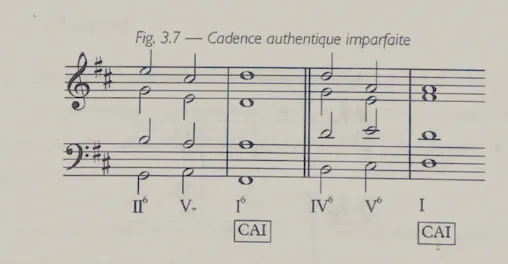
Plagal Cadenza (PL)
- IV-I
- Is more rare in tonal music but happens
- Usually found at the end of a piece, and following a Perfect Authentic Cadenza
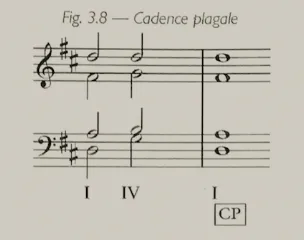
Demi-Cadenza (DC)
- Suspensive cadenza
- X-V
- Acts a little bit like a comma in the musical phrasing
- We always suppose that something else will follow it
- Generally, the V chord will be in root position
- Generally, this cadenza will be followed by some conclusive cadenza (PAC, AC or IC) later in the phrase.
- Usually seen as triad (as opposed to a dominant 7th chord, which we’ll study later)
The melody template we used to use looked a bit like this:
X X X DC > X X X IC/AC > X X X DC > X X X PAC
Even if V is followed by I, it CAN be a demi-cadenza, it depends on the phrasing / phrase structure.
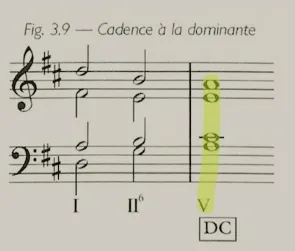
Broken Cadenza (BC)
- Probably my favourite
- Looks like AC (V-I), but instead of resolving on I as expected, we substitute it for VI, IV, or III
- My favourite version is V-VI, it’s also the most used one.
- The most typical movement of this cadenza is the bass going from the 5th to the 6th degree.
- When substituting to IV, the chord will often be in the 1st inversion
- We’ll learn more about how to use this cadenza later in our studies
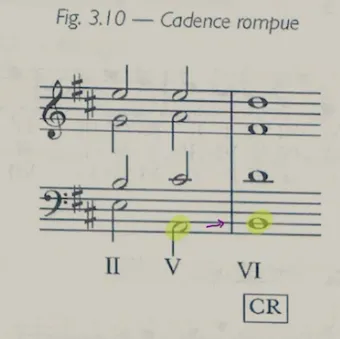
Harmonizing a Melody
So far in our studies we’ve seen how to harmonize from a given bass line when all the chords are in root position, so we haven’t been given any choice for chords.
Let’s learn a technique to help harmonize (choose chords) a given melody. Here’s a soprano line as an example to start:
Step 1: Analyse the Soprano
- Play it once to get a feel for it and for the direction
- Identify the key the melody is in
- Bb Major
- Identify the cadenzas
- in this specific exercise, there are 2 cadenzas: a DC in the middle
- Identify other elements:
- 7ths
- Harmonic marches
- Ornamental notes (Passing Tone, Escaped Note, Embroidery (?))
- For now though, in our exercises, we’ll keep it more simple and assume all notes are part of a chord, and that there are no 7ths.
Step 2: Identify Possible Chords
- When you have a note on the soprano, it can be harmonized with (at least) 3 different chords.
- i.e. if you’re in C Major and you have C on the soprano: C, Am, F
- For now, we’re not allowing ornamental notes, which means we most likely will need 1 chord per note of the melody. At least, that’s how we’re going to write our possible chords.
- The end must always be V-I

Step 3: Creation of Harmonic Scheme
Pick a coherent scheme using the tools we’ve learned
- Cycle of Fifths
- Substitutions
- Schönberg Analysis

Step 4: Write the Bass Line
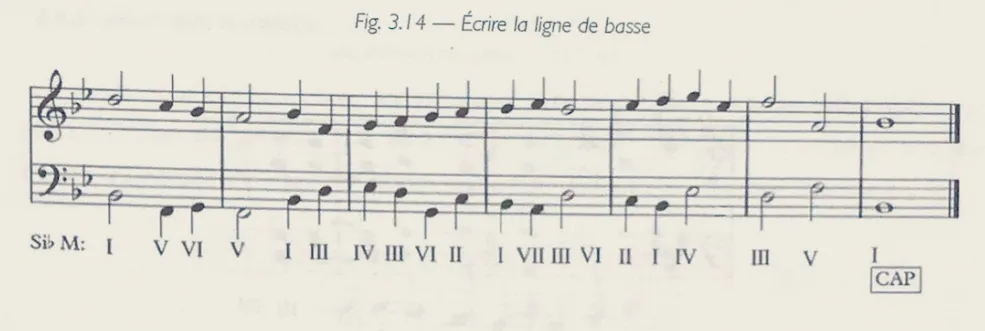
Step 5: Fill the Inner Voices
